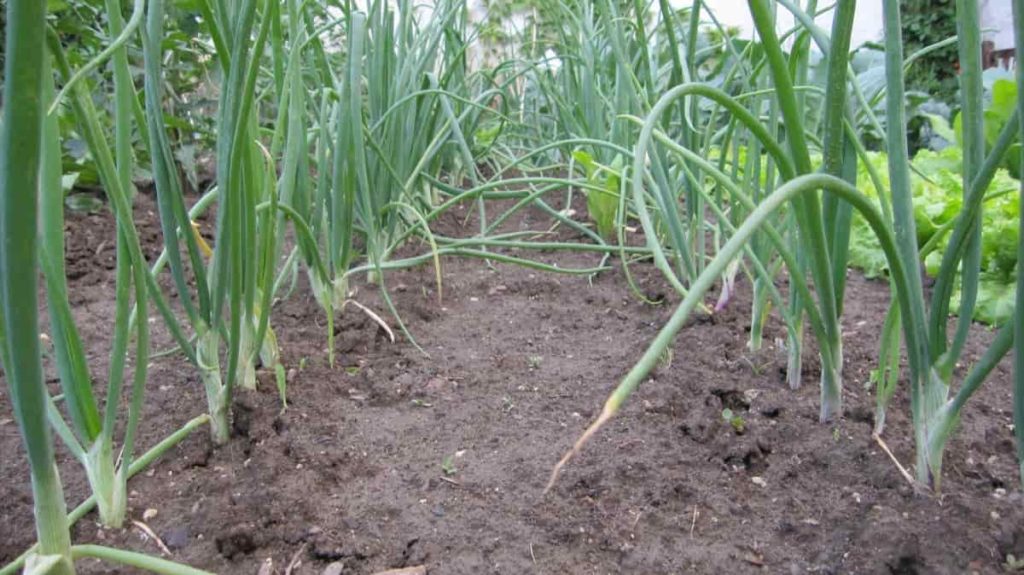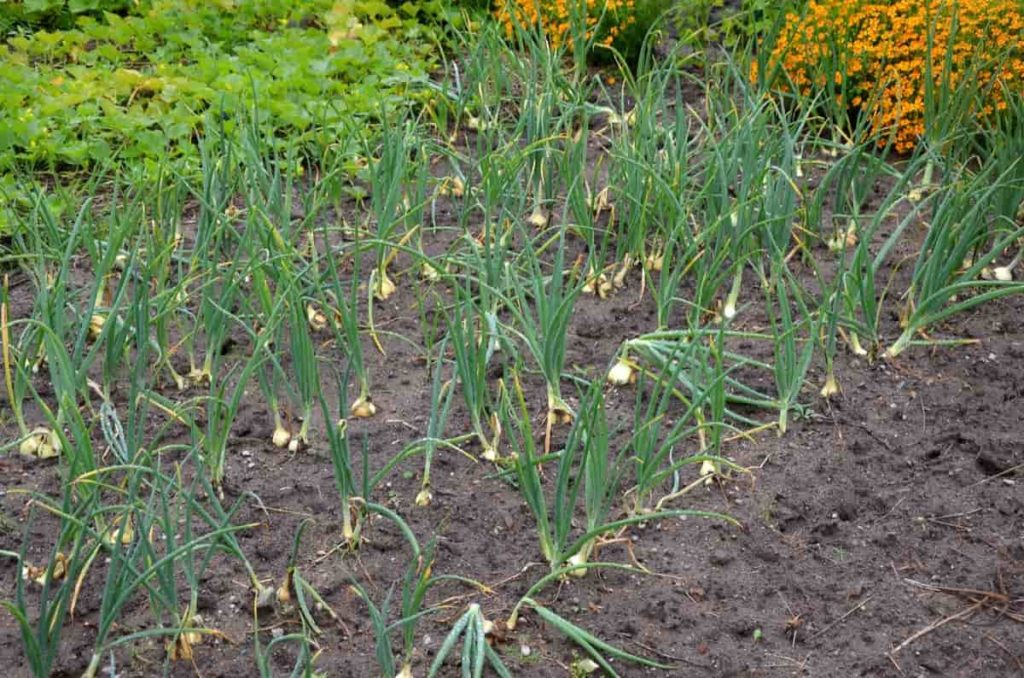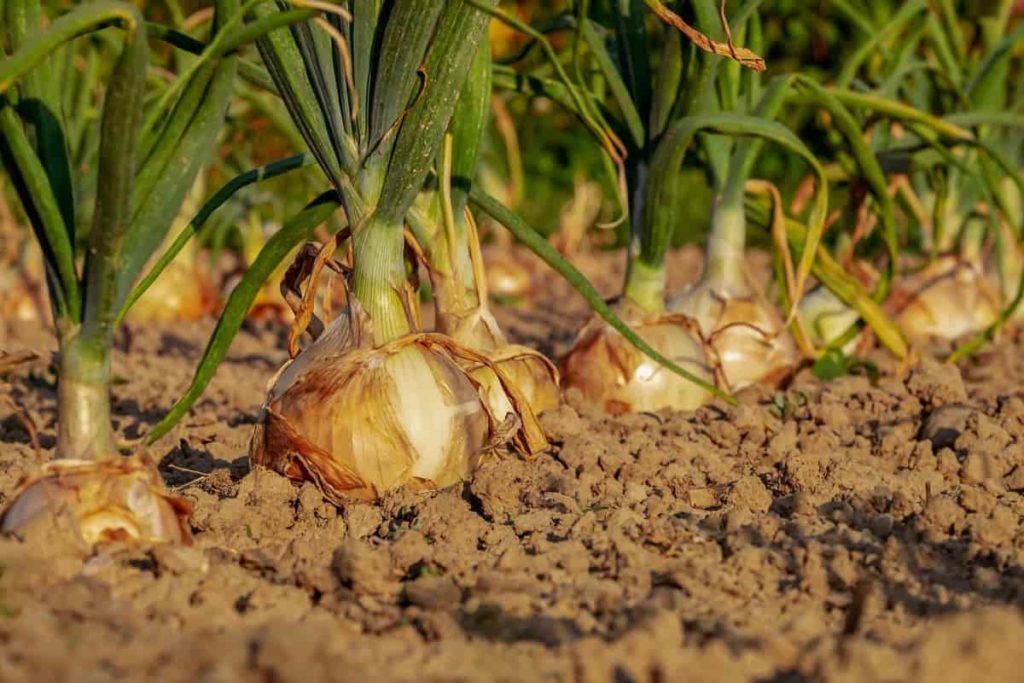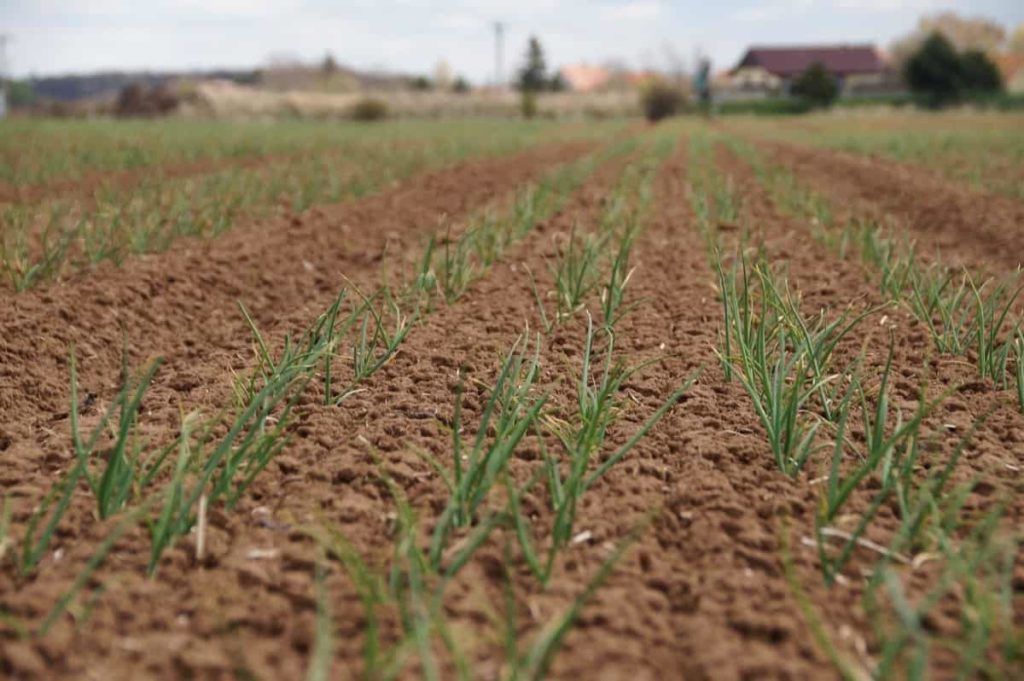Onions are one of the most important commercial bulbous vegetable crops. It is popularly used as a vegetable and spice in both immature and mature bulb stages. Onions come in different varieties, from large bulbs for dry climates to small torpedo-shaped varieties prepared for short growing seasons. When and how to plant Onions depends on your growing type and climate. Most gardeners face some of these questions when growing Onions.

How to start Onion farming from scratch
How long to Onions take to grow from seed?
It’s easy to grow Onions from the seed and allows you to choose the suitable varieties you want to grow. Buying a starting seed or set is also a great option and will give you a faster start than the seed. Onion seeds are available throughout the year and are less expensive than set. However, seeds take more time to grow.
You can easily grow Onions from seeds, but remember that these are a two-year crop, which means you plant seeds once every two years. The average Onion growth rate is 100 to 175 days from maturity. They are ready for harvesting when bulbs grow, turn yellow on top, and start falling.
How do you start an Onion seed indoors?
- Growing Onions in containers or pots at home is a great way to grow a good crop of fresh Onions when the space is slightly premium. First, start Onion seeds indoors about 8 to 10 weeks before your area’s last spring frost date. Then, follow the usual best practices to start indoor seeds: use a sterile seedling potting medium, you should keep the soil moist, and provide bright light for at least 12 hours daily after growing.
- You can also soak Onion seeds before planting to encourage germination. Soaking the sets in compost tea will protect them from disease and give them added nutrition. To start an Onion seedling indoors, fill a container with a seed starting mix almost up to the top, and then make two furrows, about 1/2 inches deep, for Onion seeds.
Can I plant Onions in the same place every year?
- Do not plant them at the same location year after year, as it may encourage the spread of the diseases affecting the crop. Instead, learn more about crop rotation. Choose a location with full sun, where other plants will not shade your Onions. The more energy they can get from sunlight, the more their bulbs can grow.
- Regular Onions, also known as the common Onion, are biennial plants that produce leaves in the first year, followed by flowers and seeds in the second year. Gardeners consider the common Onion an annual vegetable and pull bulbs at the end of the first growing season.
In case you missed it: Growing Hydroponic Spring Onions – A Full Guide

What happens if you plant too many seeds in one spot?
- Do not exceed three seeds per hole. If more than one germinates, cut the extras on the soil line. This prevents the disruption of the roots of the seedlings on it, which you will continue to grow while thinning. Indoors when Onion greens reach 5 to 6 inches tall, it is time to transplant them into individual cells. Start by carefully overturning the seedlings in your hand. Next, choose a healthy green transplant and apply them 1 to 1 1/2 inches deep in rows 12 to 15 inches apart. Place the transplants at a distance of 2 to 3 inches to produce large, dry Onions.
- The seedlings compete for nutrients, water, air, and root space when left un-thinned. Crowded plants not only discourage growth but also encourage pests and diseases. The crowd gives each other a shadow from the sun. As they grow older, it gets worse. Crowded vegetables will not produce usable roots if crowded.
- Onions should be planted barely covered with soil. If you plant deeper, they will grow shoots but are unlikely to make bulbs. In terms of depth, place your Onions in a container at least 10 to 15 inches deep. Onions are shallow roots, but it’s a good idea to pack a good amount of soil under roots to help them get proper moisture.
What month do you plant Onion seeds?
If seeds are planted very early, the cool air and soil temperature will delay the growth and emergence and cause the seedling’s growth to slow. Place the seeds in a zipper bag and seal them to prevent them from drying. Mark the bag with Onion seed date and variety. Place the zipper bag directly away from the sunlight in a warm place.
Every three days, you should check to see if the seeds are sprouted. Onions thrive in different temperature ranges but produce the best at 12 to 23°C, and most varieties are hardy to -6°C. Spring is the perfect time to plant Onion seeds outdoors.
In case you missed it: Soil Preparation for Onion Plants: Best Soil Mix, pH, and Compost

What month do you plant Onion sets?
The sets are easily available in early spring and late summer. They are usually planted in spring, from mid-March to mid-April. Some cultivars are suitable for planting from October to mid-March; they are less sensitive to cold, which would otherwise cause bolting. In spring, Onions set out as soon as they work on the ground, usually at the end of March or April, when temperatures are unlikely to fall below -2°C.
How many Onions does one seed produce?
Onion seed produces only one Onion under normal conditions. Decide how many seeds to plant; Onion seeds often don’t have a 100 percent germination rate, especially old seeds. You can grow them in clusters, which is easier to separate or thin later. So, plant 4 to 8 seeds per hole for best results. Do not plant them deeper than ¼ inches. Or you can choose, multiplying Onions, sometimes called bunch Onions or potato Onions, grow on a very simple rule: you plant a bulb, and as it grows, it is divided into clumps of several more bulbs.
How often should I water Onion seeds?
The ideal requirements of Onion water are to irrigate once a week to a depth of one inch instead of sprinkling lightly daily. Stick your finger near the plants, and put your finger on the ground. If you can’t feel moisture until your first nickel, it’s water time. In a typical 12-week growing season, irrigation with an inch of water once or twice a week, depending on the amount of rain. Overwater Onions quickly promote yellow leaves. The tops will soon fall if the plants get too much water. Once Onion bulbs were rotten, you can’t save your Onion plants.
What is the best way to grow Onions?
Seeds do not have enough time to produce large bulbs when planted in spring. The seedlings will give you a bigger bulb with the start of their head with spring plantation, but Onion sets will give you the best chance on full-body Onions. Onion sets are the best way to plant and ensure a crop of full-size Onion bulbs. The only problem is that they can be more expensive, and different types are often minimal. In addition, you may only get to choose between yellow, red, or white Onions, not the abundance of varieties within each category.
Why are my Onions all tops?
It needs enough nutrients to be healthy enough to make Onion plant bulbs in its early stages. Onion plants will give a lush growth above the ground but will fail to produce bulbs if there is too much nitrogen. Instead, select a balanced fertilizer and apply it a month after planting and then once more four weeks later.
In case you missed it: Onion Companion Plants, Onion Planting Guide

Why are my Onion greens drooping?
It is usual for Onion seedlings to droop when they reach a size where they can no longer support themselves. But size is not the only reason that Onion seedlings look droopy. You can deal with underwater or overwater, as well as extreme heat. As Onion seedlings grow, they grow longer and more leaves. The taller they grow, the harder it is to support their weight, so they bend in the middle and flop over.
Is Epsom salt good for Onions?
Soil that lacks sulfur for a particular crop like Onion can benefit from applying Epsom salt. Onion plants that are in healthy soils are less prone to pest damage. You can mix two tablespoons of Epsom salt in a gallon of water and spray the soil around the plant.
Is bone meal good for Onions?
Bone meal acts as an excellent fertilizer for a few crucial reasons. First, it is a great source of phosphorus used by new plants to produce strong roots and is perfect for root vegetables like Onions. Onions are heavy feeders, so be sure to provide plenty of nitrogen, phosphorus, and ammonium sulfate. Add one cup of equal portions of blood and bone meal fertilizer to every 10 feet row.
Do Onions like coffee grounds?
Coffee grounds work great for Onions. Coffee grounds contain nitrogen which is a necessary nutrient for Onions. You can sprinkle the coffee grounds over the beds and water them or allow rainwater to sink into them. Onions are usually like coffee grounds and contain the essential nutrients required by vegetable plants which are beneficial to them.
Why are my Onions so small?
- Applying different types of Onions incompatible with your climate will result in small Onions. Also, due to temperature fluctuations, early flowers cause small Onions. Finally, small Onions are also caused by a lack of nutrients due to competition or poor soil. Therefore, you should have a good idea of the factors that will affect the size of the Onion you can grow in your garden.
- When Onions compete with sunlight, water, and nutrients, they often fail to produce many leaves because they need to grow large bulbs. Each Onion leaf equates to the ring on the bulb, so healthy leaves mean large Onions. Depending on the weather, you can water Onions once or twice a week. Once the tops turn yellow, stop watering and fall to encourage bulbs to mature and avoid rotting problems. Onions grow very well in rich, organic soil with a pH of 6.5-6.8.
Do Onions need a full sun?
It takes little effort to learn to grow Onions, as they are one of the easiest vegetables to take care of. First, grow Onions in full sun and excellent drainage area. Then, coordinate your plantation timeline based on your required types and available daily light hours.
What fertilizer do Onions need?
- Onions like fertile soil, require much nitrogen and should not be grown on freshly manured soil. Instead, dig over and manure the ground several months before planting. Onions need a high source of nitrogen. Therefore, you should apply nitrogen-based fertilizer (ammonium sulfate or nitrate) at one cup per twenty feet. The first application is three weeks after planting and then continue with applications every 2 to 3 weeks. High potash tomato fertilizer will help the bulbs to ripen and develop healthy, firm tissue, which also has the best-keeping qualities.
- Onions grow well in well-drained soil with a pH between 6.0 and 7.0 and high organic matter. Onions grow best in fertile soil, which drains well. But they also grow in sandy or clay soils modified from organic materials. Onions only require enough nitrogen until mid-July. Apply about one and a half inches deep of organic material on the soil and work it up to a depth of eight inches.
In case you missed it: Growing Small Onions In Pots – For Balcony, Terrace, Backyard

Why do Onions split when growing?
Some varieties of Onions are more susceptible to splits; for example, some red types and Sweet Spanish Onions will burst if planted too far apart. Otherwise, splits can be caused by overfertilization, uneven water, temperature fluctuations, and deep plantings. Several reasons for your Onion to split include; being planted very deeply, very shallow, too much distance between your Onions, inconsistent water, too much fertilization, too much organic fertilizer, and different varieties.
Why are the tips of my Onion plants turning yellow?
- Onion plants thrive in soil with permanent moisture, meaning you should be watered regularly and adequately. Unfortunately, knowing the leaves are turning yellow may mean you’re giving over or underwater. Onion leaves can also be yellow with a lack of nitrogen and too much nitrogen, so you should be careful to add trace elements.
- Too much or enough light can cause yellow plants; too much or too little water or fertilizer can also be a problem. If the soil around your plants has dried up entirely between the water, your seedlings are probably just thirsty. Remember that planting Onions more than once in one place every four years is not recommended; otherwise, pests and diseases will accumulate on the plot, and Onions will extract enough nutrients from the soil.
Why are my Onion plants curling?
Typically, thrips prefer to eat plant tissue from new emerging leaves. Apart from curling Onion leaves, these insects produce silver or white stripes on the leaves. Young leaves appear deformed, and severely injured leaves can also turn brown and die. Different pesticides can kill most, or neem oil are more effective. Make sure to coat the plant well to compensate for the shape of the Onion leaves.
What not to plant with Onions?
All types of Peas and Beans can be harmful to Onions. The same is true of Sage and Asparagus. Another bad Onion neighbor is another Onion plant. Onions often suffer from Onion maggots, which can travel easily from plant to plant in a nearby place simultaneously. Onions make great planting companions because of their ability to improve the flavor of companion plants and prevent insects like aphids, Japanese beetles, and rabbits. However, Peas, Pole Beans, Bush Beans, and asparagus do not grow well when planted near Onions.
Why is my Onion not making bulbs?
One possible reason for the lack of Onion bulb formation is the choice of the wrong type of Onion for your area. In their natural environment, Onions are two years old with a two-year life cycle. First-year plants bulbs, and in the second year, it flowers.
How do I know when Onions are ready to harvest?
Let the Onions grow and mature for full-size bulbs. They are ready for harvesting when bulbs grow and turn yellow on tops start falling. Pull them up, shake the soil and keep them out for treatment with still attached peaks. It is not good to leave Onions in the ground for more than two weeks after the tops die. An acre of land can produce 20 to 25 tons of Onions depending on weather conditions, soil type, and Onion varieties.
In case you missed it: Making Compost From Onions For Home Garden

Conclusion
Growing large Onions in your garden is a satisfying project. Knowing how to grow Onions will make adding this wonderful vegetable to your garden more manageable. Onion has a reputation for being difficult to grow, but with a little practice, most gardeners can do it. Try to grow from the first sets, as they have a success rate. This article will explain the solution to the questions that arise when you grow Onions in your yard.
- Broccoli Seed Germination and Selection
- Asparagus Seed Germination and Variety Selection
- Seasonal Flower Gardening: Best Practices for Spring, Summer, Fall, and Winter
- How to Grow Hibiscus from Flower
- Plantation Ideas for Home Decoration: A Beginners Guide
- Flower Garden Designs and Layouts for Beginners
- Planting and Spacing Techniques in Papaya: A Beginner’s Guide
- Growing Gold: Essential Techniques for Planting Pineapples
- How to Make Kalanchoe Plant Bushy: Home Remedies and Solutions
- 11 Reasons Why Your Gardenia is Not Blooming: Home Remedies and Solutions
- Eco Elegance: The Guide to Designing a Drought-Tolerant Landscape
- Gardening on a Slope: Strategies for Hillside Landscaping
- Nourish and Flourish: Top Organic Mulches for Thriving House Plants
- Everything You Want to Know about Indian Mogra Flower: Discover Uses and Growing
- Green Thumb Success: Expert Tips for Cultivating Greenhouse Pumpkins All Year Round
- Maximize Growth & Flavor: The Ultimate Guide to Companion Planting in Herb Gardens
- How to Control Rhododendron Problems Naturally: Home Remedies and Organic Ways to Fix Them
- Natural Magic: The Remarkable Benefits of Cinnamon for Plants
- Best Steps to Revive Dying Tulip with Natural and Organic Treatment
- 10 Reasons Why Your Angel Trumpet is Not Blooming: Remedies and Treatment
- How to Fix Periwinkle Leaf and Flower-Related Problems: Natural Remedies and Solutions
- How to Fix Zinnias Leaf and Flower Problems: Discover Natural and Home Remedies
- Organic Steps to Induce Lemon Tree Flowers: A Comprehensive Guide
- Bloom Booster: Crafting the Perfect Homemade Bougainvillea Fertilizer
- Optimizing Growth: A Guide to Applying NPK Fertilizer for Potted Plants
- 10 Best Homemade Fertilizers for Rubber Plant: DIY Recipes and Application Method
- How to Boost Female Pumpkin Flowers: Effective Steps for More Flowers and High Yields
- Transform Your Indoor Garden: Top Benefits of Pink Salt for Houseplants
- 10 Best Homemade Fertilizers for Peacock Plants (Calathea): Easy DIY Guide
- Unlock Blooms: 9 Reasons Why Your Potted Chrysanthemum is Not Blooming
- 8 Reasons Why Your Potted Hibiscus is Not Blooming: Fix it with Simple Solutions
- Unlock Blooms: 9 Key Reasons Your Potted Frangipani Won’t Flower
- 10 Reasons Why Is My Ice Plant Not Blooming: Remedies and Treatment
- 10 Reasons Why My Potted Hydrangea Not Blooming: Treatment and Remedies
- 10 Reasons Why is My Wisteria Not Blooming: Remedies and Treatment
- 10 Reasons Why is My Goldfish Plant Not Blooming: Remedies and Treatment